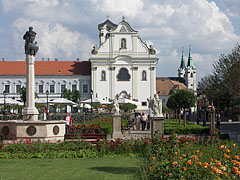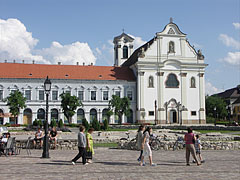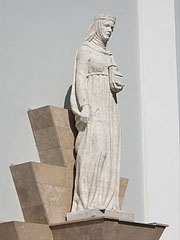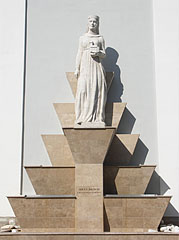(Optimizate pentru dispozitive cu ecran mic)
Downtown, main square - Vác, Ungaria
Când faceți clic:
Click pe imagini!
-

Church of the Whites (in Hungarian "Fehérek temploma"), also known as Upper Town Parish Church, it is the former Dominican Church
Data fotografierii: 13.07.20092009
Creată de: Robert Németh
Model de aparat foto: Konica Minolta Dimage A200
Vác, Ungaria
-

Municipal House (Tow Hall) of Vác
Data fotografierii: 13.07.20092009
Creată de: Robert Németh
Model de aparat foto: Konica Minolta Dimage A200
Vác, Ungaria
-

The renovated main square of Vác with charming fountain and the baroque building of the Dominican Church ("Church of the Whites", Fehérek temploma)
Data fotografierii: 24.05.20082008
Creată de: Robert Németh
Model de aparat foto: Konica Minolta Dimage A200
Vác, Ungaria
-

Fountain in the main square
Data fotografierii: 13.07.20092009
Creată de: Robert Németh
Model de aparat foto: Konica Minolta Dimage A200
Vác, Ungaria
-

Vác, Ungaria
-

Park decorated with roses in the main square with the former Dominican Church ("Church of the Whites", Fehérek temploma), and in the distance the double steeples of the Piarist Church
Data fotografierii: 24.05.20082008
Creată de: Robert Németh
Model de aparat foto: Konica Minolta Dimage A200
Vác, Ungaria
-

Wedding is very common in the magnificent sceneries of the Church of the Whites (Fehérek temploma)
Data fotografierii: 24.05.20082008
Creată de: Robert Németh
Model de aparat foto: Konica Minolta Dimage A200
Vác, Ungaria
-

Church of the Whites (Fehérek temploma) or the former Dominican Church, the ornate rococo style interior
Data fotografierii: 24.05.20082008
Creată de: Robert Németh
Model de aparat foto: Konica Minolta Dimage A200
Vác, Ungaria
-

A lot of onlookers
Data fotografierii: 24.05.20082008
Creată de: Robert Németh
Model de aparat foto: Konica Minolta Dimage A200
Vác, Ungaria
-

The glass covered exhibition in the center of the ruin garden
Data fotografierii: 24.05.20082008
Creată de: Robert Németh
Model de aparat foto: Konica Minolta Dimage A200
Vác, Ungaria
-
Church of the Whites (Fehérek temploma) with the ruin garden in the main square
Data fotografierii: 24.05.20082008
Creată de: Robert Németh
Model de aparat foto: Konica Minolta Dimage A200
Vác, Ungaria
Church of the Whites (Fehérek temploma) with the ruin garden in the main square - Vác, Ungaria -
Statue of Saint Hedwig (Jadwiga of Poland) in the side of the Church of the Whites (Fehérek temploma)
Data fotografierii: 24.05.20082008
Creată de: Robert Németh
Model de aparat foto: Konica Minolta Dimage A200
Vác, Ungaria
Statue of Saint Hedwig (Jadwiga of Poland) in the side of the Church of the Whites (Fehérek temploma) - Vác, Ungaria -
Statue of Saint Hedwig (Jadwiga of Poland) in the side of the Church of the Whites (Fehérek temploma), with a babbling fountain
Data fotografierii: 24.05.20082008
Creată de: Robert Németh
Model de aparat foto: Konica Minolta Dimage A200
Vác, Ungaria
Statue of Saint Hedwig (Jadwiga of Poland) in the side of the Church of the Whites (Fehérek temploma), with a babbling fountain - Vác, Ungaria -
Data fotografierii: 24.05.20082008
Creată de: Robert Németh
Model de aparat foto: Konica Minolta Dimage A200
Vác, Ungaria
- Vác, Ungaria -
Data fotografierii: 24.05.20082008
Creată de: Robert Németh
Model de aparat foto: Konica Minolta Dimage A200
Vác, Ungaria
- Vác, Ungaria -
Data fotografierii: 24.05.20082008
Creată de: Robert Németh
Model de aparat foto: Konica Minolta Dimage A200
Vác, Ungaria
- Vác, Ungaria -
Main square, baroque statue near the Town Hall and the Provost Major's Palace (in Hungarian "Nagypréposti palota") in the background
Data fotografierii: 13.07.20092009
Creată de: Robert Németh
Model de aparat foto: Konica Minolta Dimage A200
Vác, Ungaria
Main square, baroque statue near the Town Hall and the Provost Major's Palace (in Hungarian "Nagypréposti palota") in the background - Vác, Ungaria -
Main square, baroque statue at the Town Hall
Data fotografierii: 13.07.20092009
Creată de: Robert Németh
Model de aparat foto: Konica Minolta Dimage A200
Vác, Ungaria
Main square, baroque statue at the Town Hall - Vác, Ungaria -
Baroque facade of the Town Hall
Data fotografierii: 13.07.20092009
Creată de: Robert Németh
Model de aparat foto: Konica Minolta Dimage A200
Vác, Ungaria
Baroque facade of the Town Hall - Vác, Ungaria -
Fountain in the main square, and farther in the shadow it is the Church of the Whites with the sculpture of Saint Dominic of Osma
Data fotografierii: 13.07.20092009
Creată de: Robert Németh
Model de aparat foto: Konica Minolta Dimage A200
Vác, Ungaria
Fountain in the main square, and farther in the shadow it is the Church of the Whites with the sculpture of Saint Dominic of Osma - Vác, Ungaria -
Sentimental picture in the main square of Vác
Data fotografierii: 13.07.20092009
Creată de: Robert Németh
Model de aparat foto: Konica Minolta Dimage A200
Vác, Ungaria
Sentimental picture in the main square of Vác - Vác, Ungaria -
The colorful houses of the main square
Data fotografierii: 13.07.20092009
Creată de: Robert Németh
Model de aparat foto: Konica Minolta Dimage A200
Vác, Ungaria
The colorful houses of the main square - Vác, Ungaria -
Baroque statue on a column in front of the former Dominican Church (the "Church of the Whites")
Data fotografierii: 13.07.20092009
Creată de: Robert Németh
Model de aparat foto: Konica Minolta Dimage A200
Vác, Ungaria
Baroque statue on a column in front of the former Dominican Church (the "Church of the Whites") - Vác, Ungaria -
Statue of Saint Hedwig (Jadwiga of Poland) near the Church of the Whites (Fehérek temploma)
Data fotografierii: 13.07.20092009
Creată de: Robert Németh
Model de aparat foto: Konica Minolta Dimage A200
Vác, Ungaria
Statue of Saint Hedwig (Jadwiga of Poland) near the Church of the Whites (Fehérek temploma) - Vác, Ungaria -
Data fotografierii: 13.07.20092009
Creată de: Robert Németh
Model de aparat foto: Konica Minolta Dimage A200
Vác, Ungaria
- Vác, Ungaria -
Data fotografierii: 13.07.20092009
Creată de: Robert Németh
Model de aparat foto: Konica Minolta Dimage A200
Vác, Ungaria
- Vác, Ungaria -
Data fotografierii: 09.03.20142014
Creată de: Robert Németh
Model de aparat foto: Konica Minolta Dimage A200
Vác, Ungaria
- Vác, Ungaria -
Data fotografierii: 09.03.20142014
Creată de: Robert Németh
Model de aparat foto: Konica Minolta Dimage A200
Vác, Ungaria
- Vác, Ungaria -
Data fotografierii: 09.03.20142014
Creată de: Robert Németh
Model de aparat foto: Konica Minolta Dimage A200
Vác, Ungaria
- Vác, Ungaria -
Data fotografierii: 09.03.20142014
Creată de: Robert Németh
Model de aparat foto: Konica Minolta Dimage A200
Vác, Ungaria
- Vác, Ungaria -
Data fotografierii: 09.03.20142014
Creată de: Robert Németh
Model de aparat foto: Konica Minolta Dimage A200
Vác, Ungaria
- Vác, Ungaria -
Data fotografierii: 09.03.20142014
Creată de: Robert Németh
Model de aparat foto: Konica Minolta Dimage A200
Vác, Ungaria
- Vác, Ungaria -
Data fotografierii: 09.03.20142014
Creată de: Robert Németh
Model de aparat foto: Konica Minolta Dimage A200
Vác, Ungaria
- Vác, Ungaria -
Data fotografierii: 09.03.20142014
Creată de: Robert Németh
Model de aparat foto: Konica Minolta Dimage A200
Vác, Ungaria
- Vác, Ungaria -
Data fotografierii: 09.03.20142014
Creată de: Robert Németh
Model de aparat foto: Konica Minolta Dimage A200
Vác, Ungaria
- Vác, Ungaria -
Data fotografierii: 09.03.20142014
Creată de: Robert Németh
Model de aparat foto: Konica Minolta Dimage A200
Vác, Ungaria
- Vác, Ungaria -
Data fotografierii: 09.03.20142014
Creată de: Robert Németh
Model de aparat foto: Konica Minolta Dimage A200
Vác, Ungaria
- Vác, Ungaria -
Data fotografierii: 09.03.20142014
Creată de: Robert Németh
Model de aparat foto: Konica Minolta Dimage A200
Vác, Ungaria
- Vác, Ungaria -
Data fotografierii: 09.03.20142014
Creată de: Robert Németh
Model de aparat foto: Konica Minolta Dimage A200
Vác, Ungaria
- Vác, Ungaria -
Data fotografierii: 09.03.20142014
Creată de: Robert Németh
Model de aparat foto: Konica Minolta Dimage A200
Vác, Ungaria
- Vác, Ungaria -
Data fotografierii: 09.03.20142014
Creată de: Robert Németh
Model de aparat foto: Konica Minolta Dimage A200
Vác, Ungaria
- Vác, Ungaria -
Data fotografierii: 09.03.20142014
Creată de: Robert Németh
Model de aparat foto: Konica Minolta Dimage A200
Vác, Ungaria
- Vác, Ungaria -
Data fotografierii: 09.03.20142014
Creată de: Robert Németh
Model de aparat foto: Konica Minolta Dimage A200
Vác, Ungaria
- Vác, Ungaria -
Data fotografierii: 09.03.20142014
Creată de: Robert Németh
Model de aparat foto: Konica Minolta Dimage A200
Vác, Ungaria
- Vác, Ungaria -
Data fotografierii: 09.03.20142014
Creată de: Robert Németh
Model de aparat foto: Konica Minolta Dimage A200
Vác, Ungaria
- Vác, Ungaria -
Data fotografierii: 09.03.20142014
Creată de: Robert Németh
Model de aparat foto: Konica Minolta Dimage A200
Vác, Ungaria
- Vác, Ungaria -
Data fotografierii: 09.03.20142014
Creată de: Robert Németh
Model de aparat foto: Konica Minolta Dimage A200
Vác, Ungaria
- Vác, Ungaria -
Data fotografierii: 09.03.20142014
Creată de: Robert Németh
Model de aparat foto: Konica Minolta Dimage A200
Vác, Ungaria
- Vác, Ungaria -
Data fotografierii: 09.03.20142014
Creată de: Robert Németh
Model de aparat foto: Konica Minolta Dimage A200
Vác, Ungaria
- Vác, Ungaria -
Data fotografierii: 09.03.20142014
Creată de: Robert Németh
Model de aparat foto: Konica Minolta Dimage A200
Vác, Ungaria
- Vác, Ungaria -
Data fotografierii: 09.03.20142014
Creată de: Robert Németh
Model de aparat foto: Konica Minolta Dimage A200
Vác, Ungaria
- Vác, Ungaria -
Data fotografierii: 09.03.20142014
Creată de: Robert Németh
Model de aparat foto: Konica Minolta Dimage A200
Vác, Ungaria
- Vác, Ungaria -
Data fotografierii: 09.03.20142014
Creată de: Robert Németh
Model de aparat foto: Konica Minolta Dimage A200
Vác, Ungaria
- Vác, Ungaria -
Data fotografierii: 09.03.20142014
Creată de: Robert Németh
Model de aparat foto: Konica Minolta Dimage A200
Vác, Ungaria
- Vác, Ungaria -
Data fotografierii: 09.03.20142014
Creată de: Robert Németh
Model de aparat foto: Konica Minolta Dimage A200
Vác, Ungaria
- Vác, Ungaria -
Data fotografierii: 09.03.20142014
Creată de: Robert Németh
Model de aparat foto: Konica Minolta Dimage A200
Vác, Ungaria
- Vác, Ungaria -
Data fotografierii: 09.03.20142014
Creată de: Robert Németh
Model de aparat foto: Konica Minolta Dimage A200
Vác, Ungaria
- Vác, Ungaria -
Data fotografierii: 09.03.20142014
Creată de: Robert Németh
Model de aparat foto: Konica Minolta Dimage A200
Vác, Ungaria
- Vác, Ungaria -
Data fotografierii: 09.03.20142014
Creată de: Robert Németh
Model de aparat foto: Konica Minolta Dimage A200
Vác, Ungaria
- Vác, Ungaria -
Data fotografierii: 09.03.20142014
Creată de: Robert Németh
Model de aparat foto: Konica Minolta Dimage A200
Vác, Ungaria
- Vác, Ungaria -
Data fotografierii: 09.03.20142014
Creată de: Robert Németh
Model de aparat foto: Konica Minolta Dimage A200
Vác, Ungaria
- Vác, Ungaria -
Data fotografierii: 09.03.20142014
Creată de: Robert Németh
Model de aparat foto: Konica Minolta Dimage A200
Vác, Ungaria
- Vác, Ungaria -
Data fotografierii: 09.03.20142014
Creată de: Robert Németh
Model de aparat foto: Konica Minolta Dimage A200
Vác, Ungaria
- Vác, Ungaria -
Data fotografierii: 09.03.20142014
Creată de: Robert Németh
Model de aparat foto: Konica Minolta Dimage A200
Vác, Ungaria
- Vác, Ungaria -
Data fotografierii: 09.03.20142014
Creată de: Robert Németh
Model de aparat foto: Konica Minolta Dimage A200
Vác, Ungaria
- Vác, Ungaria -
Data fotografierii: 09.03.20142014
Creată de: Robert Németh
Model de aparat foto: Konica Minolta Dimage A200
Vác, Ungaria
- Vác, Ungaria
Click pe imagini!
Caracteristici, proprietăți
Locație:
Coordonatele GPS: Latitudine 47°46'41", Longitudine 19°7'39" (N47 46.68 - E19 7.65)
Informații, povestiri scurte, fapte interesante
 Park decorated with roses in the main square with the former Dominican Church ("Church of the Whites", Fehérek temploma), and in the distance the double steeples of the Piarist Church
Park decorated with roses in the main square with the former Dominican Church ("Church of the Whites", Fehérek temploma), and in the distance the double steeples of the Piarist Church
The "Március 15. tér" ("March 15 Square") in Vác is one of the most beautiful baroque town square in Hungary today. The square received its current form in 2006 by the plans of Frigyes Pogány and Miklós Horler, but its typical triangular shape was developed by German settlers who arrived here after the Mongol Invasion in the 13th century.
 Wedding is very common in the magnificent sceneries of the Church of the Whites (Fehérek temploma)
Wedding is very common in the magnificent sceneries of the Church of the Whites (Fehérek temploma)
This church in Vác initially belonged to the Dominican religious order, the construction was begun in 1699 but it was completed only in 1755, led by Márton Kalcher. The rococo style interior of the church was created around 1770. The altarpiece on the columned high altar represents Pope Pius V who is begging for the success of the battle against the Turks.
The building received its "Church of the Whites" (or the "Whites' Church", in Hungarian "Fehérek temploma") name after the white religious habit of the Dominican monks that they wear under their black cloak (aka "cappa"). Surprisingly while the Dominicans were called for example in Hungary as the "White Monks", in England and other countries they are called "Black Friars" due to their black cloak. By the way, the name "White Monks" usually refers to the Cistercian friars, but sometimes it is used in relation with other religious orders as well.
It is worth to mention the statues on the facade of the church, on the two sides of the lyre-shaped window there are statues of St. Dominic and St. Emeric, as well as above it a statue of the Immaculate Conception (of Virgin Mary) can be seen. Interestingly the steeple (tower) of the Whites' Church is not on that side which has the main entrance and faces the main square, but placed on the other side of the building.
 Church of the Whites (Fehérek temploma) with the ruin garden in the main square
Church of the Whites (Fehérek temploma) with the ruin garden in the main square
The ruin garden in the middle of the town square of Vác contains the wall remains of the medieval St. Michael's Church (in Hungarian "Szent Mihály-templom") and the cemetery garden. The part that is covered with the modern glass roof is a 18th-century crypt (undercroft or "lower church"), inside it today there is an exhibition of the history of the former religious building. The St. Michael's Church stood on this place until 1761, for approximately five hundred years. The building played a dominant role in forming the surrounding cityscape, at a time there were attempts to extend it and convert into a cathedral, but it was unsuccessful. In the Turkish era Calvinists occupied the ruined church for themselves, but in 1761 it was finally demolished.
 Statue of Saint Hedwig (Jadwiga of Poland) in the side of the Church of the Whites (Fehérek temploma)
Statue of Saint Hedwig (Jadwiga of Poland) in the side of the Church of the Whites (Fehérek temploma)
Queen Jadwiga of Poland was born in 1373 as the daughter of King Louis I of Hungary and Elizabeth of Bosnia. Just like St. Elizabeth of Hungary she was the patron of the poor people and the orphans. She distributed her assets among the poors and set up a foundation for the University of Kraków (aka Kraków Academy, today Jagiellonian University or in Polish "Uniwersytet Jagielloński"). She died in Kraków, Poland in 1399 at a young age (she was only 26), during the birth of her first child.
 Statue of Saint Hedwig (Jadwiga of Poland) in the side of the Church of the Whites (Fehérek temploma), with a babbling fountain
Statue of Saint Hedwig (Jadwiga of Poland) in the side of the Church of the Whites (Fehérek temploma), with a babbling fountain
The body of St. Hedwig (in Polish Jadwiga) was buried in Kraków, Poland, below the altar of the Wawel Cathedral. Not in the royal crypt because everybody was sure she will be canonized soon. But this happened only in 1997, thanks to Pope John Paul II (born as Karol Józef Wojtyła) the first Polish Bishop of Rome. Independently from this she was venerated as a saint already after her death, and she was always represented according to this.
Since 2006 St. Hedwig is the patron saint of the Danube Bend (in Hungarian "Dunakanyar"), the region where Vác is located. The statue in Vác beside the Church of the Whites ("Fehérek temploma") was created by Tibor Horváth and László Sáros in 2006, in the year when the town square was renovated.
 Main square, baroque statue near the Town Hall and the Provost Major's Palace (in Hungarian "Nagypréposti palota") in the background
Main square, baroque statue near the Town Hall and the Provost Major's Palace (in Hungarian "Nagypréposti palota") in the background
The Provost's Palace (in Hungaran "Nagypréposti palota") was built in the mid-18th century, it is the residence of the great provost (or high provost, provost major). The provost is a high-rank senior official in many Christian Churches, he is the head of the chapter and the adviser of the bishop. The renovated building is the home of the Diocesan Collection of Vác.
 Municipal House (Tow Hall) of Vác
Municipal House (Tow Hall) of Vác
The Town Hall is considered the most significant baroque secular building of Vác. According to a map from 1680 formerly there was a Turkish bath building on its site, but a source from 1718 already shows a town hall here. The present-day building was built from 1730 until the visit of Empress Maria Theresa in 1764.
The central figure on the facade of the building is the statue of Justitia (or Iustitia, Lady Justice), the goddess of justice. There are two other female figures on both sides with coat of arms, one is of Hungary and the other one is of Bishop Kristóf Migazzi who financed the construction.
 Church of the Whites (in Hungarian "Fehérek temploma"), also known as Upper Town Parish Church, it is the former Dominican Church
Church of the Whites (in Hungarian "Fehérek temploma"), also known as Upper Town Parish Church, it is the former Dominican Church
During the renovations of the church of the 1990s, more precisely in 1994 the workers found a forgotten entrance, a way down behind a bricked-up door. This way led to a vaulted crypt where there were a lot of (total of 265) 170 to 270-year-old highly decorated coffins stacked almost to the ceiling. Instead of skeletons there were naturally formed mummies in the coffins, dressed in funeral clothes.
With the permission of the Bishopric of Vác scientific studies have been performed on the "Mummies of Vác" and the site as well. Today the funerary objects are kept in the Tragor Ignác Museum that conducted the exploration, and the bodies (except a baby mummy) are within the Anthropological Collection of the Hungarian Natural History Museum ("Magyar Természettudományi Múzeum"). The finds give an insight into the everyday life, habits and beliefs of the people of different origins, ages and social backgrounds, who lived here about 200 years ago. Moreover, even their facial features can be discovered thanks to the scientists.
A sensational discovery related to the finds that some of the found mummified people were probably fully resistant against more deadly diseases when they lived. The cause of it is still under investigation, but the resistance was probably due to genetic mutations. In the near future this research could be a great help to the medical science.
Vác - Mai multe galerii foto:
Ați putea fi, de asemenea, interesat în (Legate de pagini):
Destinații în ghidul de călătorie:
Vác (232 poze + 2 imagini panoramice)
Danube Bend (Dunakanyar) (1 769 poze + 6 imagini panoramice)
Pest megye (county) (15 122 poze + 50 imagini panoramice)
Budapest şi împrejurimile (Ungaria Centrală) (15 989 poze + 52 imagini panoramice)
Ungaria (27 287 poze + 163 imagini panoramice)
și în plus:
(în acest loc: Pest megye și Danube Bend)
Pilis Mountains (Pilis hegység) (335 poze)
Buda Hills (Budai-hegység) (8 632 poze + 21 imagini panoramice)
Gödöllő Hills (Gödöllői-dombság) (4 203 poze + 21 imagini panoramice)
Visegrád Mountains (Visegrádi-hegység) (116 poze + 1 imagini panoramice)
Cegléd (125 poze + 2 imagini panoramice)
Ráckeve (92 poze)
Dunakeszi (259 poze)
Göd (23 poze)
Nagykőrös (250 poze + 2 imagini panoramice)
Nagymaros (31 poze)
Pilisvörösvár (88 poze)
Szentendre (597 poze + 1 imagini panoramice)
Visegrád (220 poze + 1 imagini panoramice)
Esztergom (110 poze + 1 imagini panoramice)
Dunakeszi (259 poze)
Göd (23 poze)
Nagymaros (31 poze)
Szentendre (597 poze + 1 imagini panoramice)
Visegrád (220 poze + 1 imagini panoramice)
Csővár (105 poze)
Kóspallag (53 poze)
Márianosztra (37 poze)
Nagybörzsöny (4 poze)
Pilisszentkereszt (122 poze)
Nógrád (181 poze)
Zsámbék
Fiecare fotografie panoramică aici:
Vác (2 poze)
Danube Bend (Dunakanyar) (6 poze)
Pest megye (county) (50 poze)
Budapest şi împrejurimile (Ungaria Centrală) (52 poze)
Ungaria (163 poze)
Europa (165 poze)
Fiecare fotografie normală aici:
Vác (232 poze / 4 galerii)
Danube Bend (Dunakanyar) (1 769 poze / 31 galerii)
Pest megye (county) (15 122 poze / 221 galerii)
Budapest şi împrejurimile (Ungaria Centrală) (15 989 poze / 234 galerii)
Ungaria (27 287 poze / 462 galerii)
Europa (30 494 poze / 523 galerii)
https://www.panadea.com/ro/guidebook/vac/photos/gal-001

Adauga la Favorite Adauga la Favorite
Partaja cu prietenii dvs.!
etc.
Nostru ghid turistic conține:
Un număr mare de fotografii și imagini panoramice, cu o mulțime de informații și curiozități.
- 214 destinații de călătorie
- 165 imagini panoramice
- 30 494 alte poze
Colecție mare de fotografii selectate: calitate excelentă, înaltă rezoluție și culori naturale
Toate drepturile rezervate
- ©2010-2022
Neuronit Creative Studio - Mogyoród / Budapesta / Ungaria





